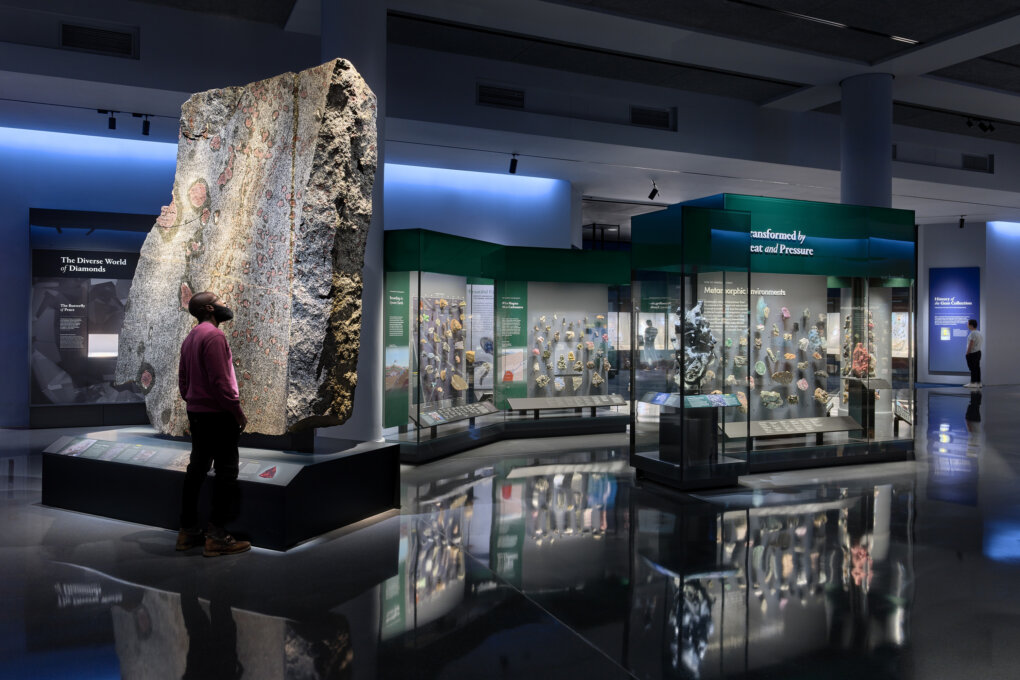







Partagez sur
The Allison and Roberto Mignone Halls of Gems and Minerals
Par : Ralph Appelbaum Associates, Inc.
GRANDS PRIX DU DESIGN – 15e édition
Discipline : Design d’intérieur
Catégories : Culture, sport & loisir / Musée & galerie : Certification Or
In 2021, the American Museum of Natural History’s world-renowned Allison and Roberto Mignone Halls of Gems and Minerals were reopened with a completely new presentation. Within the renovated halls, state-of-the-art lighting draws out mineral colors, crystal habits and sculptural forms, optimized to highlight color variation and refraction in gems and jewelry. The extraordinary role minerals play in science and culture is highlighted with up-to-date knowledge. An open layout invites curiosity-driven exploration. The halls’ elegant design carefully integrates interpretive graphics and media programs for generations of diverse Museum visitors.
Foremost in the renovation concept was showcasing the Museum’s vast and diverse mineralogy collection. Over 5,000 mineral specimens – more than half of which have not previously been displayed – are now on view in state-of-the-art custom casework. Rich graphics engage visitors in deepening their understanding of the scientific, cultural, geographic, historic, and human connections to individual specimens and mineral groups. Carefully integrated media produced by the Museum’s Exhibition department makes visible the mostly unseen processes that form minerals over time and scales.
The Gem Hall includes a display of nearly 2,500 objects from the Museum’s world-class collection accompanied by digital labels to identify the gems on display. These include precious stones, carvings, and stunning jewelry from around the world that were fashioned from naturally beautiful minerals.
The Mineral Hall is anchored by a selection of large minerals that encourage visitor engagement, including a four-ton slab of garnet-bearing amphibolite, a six-foot tall column of polished labradorite, and a grouping of beryl crystals. A pair of towering, sparkling amethyst geodes that are among the world’s largest on display welcome visitors at the south entry and serve as a glittering destination for those entering from the north.
The Mineral Hall comprises four sections. Mineral Forming Environments is a set of cases in the center of the hall dedicated to the environments and processes by which minerals form. At the four corners, Mineral Fundamentals displays explore the overarching concepts of mineral sciences, from the evolution and diversification of minerals to their properties to how they have been used by humans from prehistory to the present day. Systematic Classification, a display running along the west wall, contains 659 specimens that represent the chemical classification system that scientists use to organize Earth’s mineral species, as well as an interactive feature in which visitors can explore forming minerals from the elements on the periodic table. Finally, Minerals & Light room, explores the optical properties of minerals—their interaction with light and features a wall-sized panel of fluorescent rock that glows in shades of orange and green.
Clusters of double-sided casework, its design inspired by crystal forms, presents a rich array of specimens contextualized with accessible yet scientifically accurate stories, illustrations, diagrams, and images. Enhanced by cultural and technological detail, these stories connect minerals to visitors’ everyday lives. Animations further help demystify the age-long processes that create minerals and crystals.
Collaboration
Autre : Ralph Appelbaum Associates
Autre : American Museum of Natural History
Éclairage : Renfro Design Group
Ingénierie : Picco Engineering










